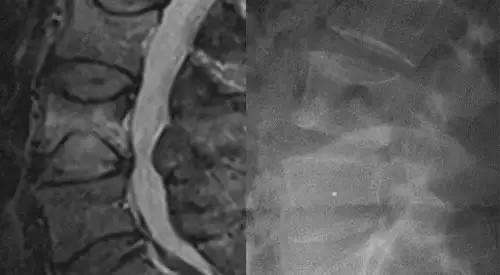Vertebral fractures
"Sudden, acute back pain can be a symptom of a spinal fracture".
DR. VÍCTOR RODRIGO
DIRECTOR. NEUROSURGERY DEPARTMENT

Vertebral fractures are usually caused by trauma of a certain intensity, although if the bone is very weakened (by osteoporosis, for example), it can be fractured with a mild trauma or when carrying out a stress load.
An acute fracture can be treated in a conservative way, although it can also have surgical indication from the beginning, for example, if neurological symptomatology, radiological instability or incapacitating pain exists.

What are the symptoms of vertebral fractures?
A patient may be asymptomatic at rest, but with back or lumbar pain and even root pain when standing up and walking, which would indicate that the fracture may be unstable.
There are also radiographic criteria of instability to indicate an intervention (AO classification, TLICS etc.)
The most common symptoms are:
- Dorsal or lumbar pain.
- Symptoms due to nerve involvement.
- Inability to perform normal activity.
Do you have any of these symptoms?
You may have suffered a vertebral fracture
How are vertebral fractures diagnosed?

The diagnosis can be made with simple radiology (X-rays) although it is usually complemented with a scanner (CT) or an MRI to better assess the bone and adjacent tissues, the vertebral edema, the spinal canal, etc., even ruling out other processes.
If the fracture is known, or suspected, to be osteoporotic, the study is complemented with a bone densitometry and a blood test to evaluate the state of the bone and to indicate or not, in parallel, a treatment to improve its quality.
Carrying out preventive treatments in patients who have a history of risk (e.g. osteoporosis) can help prevent the appearance of vertebral fractures.
How are vertebral fractures treated?
If the spine is stable and the pain is controllable, it tends to be treated conservatively with oral medication, braces and relative rest.
If, after a few weeks or months, the pain is not controlled, percutaneous vertebral cementation may be indicated by means of vertebroplasty or kyphoplasty, with the objective of stabilizing the broken bone and acting on the nerve endings of the vertebral body to reduce the pain.
If one or several vertebral cementations are not sufficient to stabilize the spine, the use of osteosynthesis (bars and screws) may be required, which can also be implemented openly or percutaneously, depending on each case.
Where do we treat it?
IN NAVARRE AND MADRID



